Mattapany (18ST390)
Introduction
Mattapany (18ST390) was the 17th-century plantation and principal dwelling of Charles Calvert, the third Lord Baltimore
and Proprietor of Maryland, as well as the location of the colony's main weapons magazine. The site of the dwelling and
arms magazine, once part of a 1,200-acre manor, is located near the mouth of the Patuxent River aboard what is today the
Naval Air Station Patuxent River. Although documentary evidence indicates that Europeans had established a presence
in the area by 1637, Mattapany was not occupied until ca. 1663, when Henry Sewall, Secretary of the Maryland colony,
acquired the property. After Sewall's death in 1665, Charles Calvert married his widow, Jane, and moved to her plantation.
Mattapany remained in the Sewall/Calvert family until the 19th century, but the 17th-century dwelling house was abandoned
by the 1740s when a new manor house was built a few hundred yards away. The colonial magazine, established in the 1670s,
was in use only until the mid-1690s, when it was transferred to St. Mary's City following the Calvert family's loss of
political control in the colony and the arrival of a royal governor. By the 1770s, the house at Mattapany was described
as being in ruins.
Mattapany served as an important political center in Maryland, with Baltimore convening the Governor's Council
there on dozens of occasions between 1668 and 1689. As the home of the Maryland proprietor, Mattapany represents
the uppermost stratum of 17th-century Chesapeake society. Yet it was also the home for numerous servants and slaves,
and a garrison of up to 39 troops was at times stationed at the magazine. Mattapany could boast one of the largest
immigrant population concentrations in the colony. The interactions that played out between elite planters and middling
freeman, servants, slaves, and Indigenous Americans can be observed in the archaeological record of 18ST390. Mattapany
provides a baseline against which all other 17th-century sites can be compared. The documentary record for Mattapany,
richer than that of most 17th-century sites in Maryland, adds to the research value of the site, and makes it one of the
most significant collections from early Maryland.
Archaeological Investigations
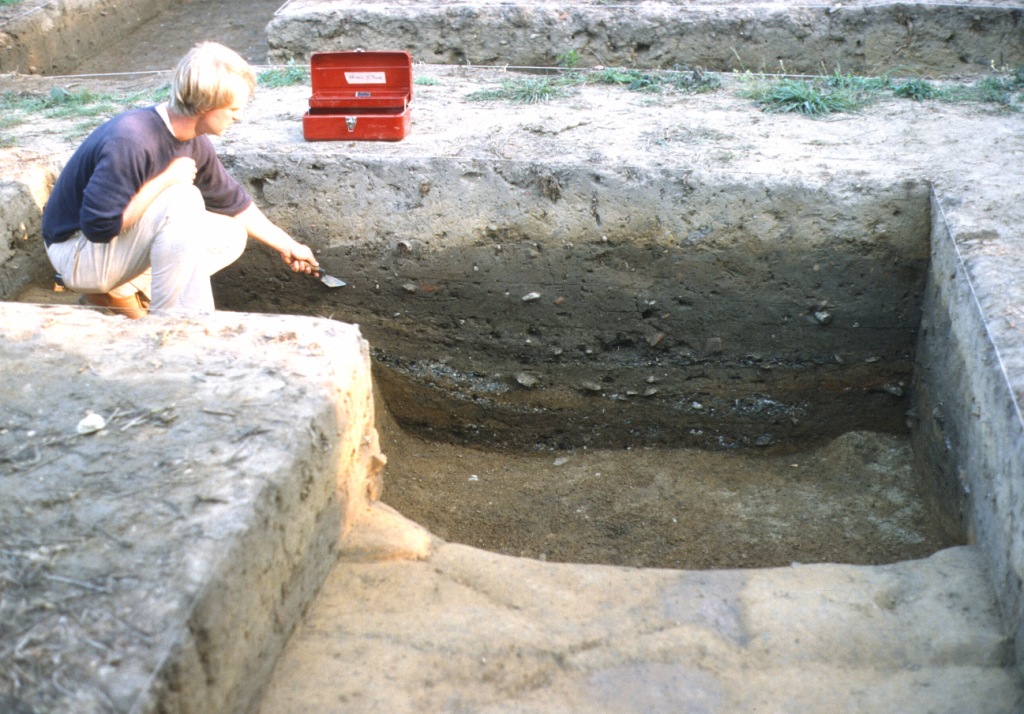 Dennis Pogue, Unit 154, magazine area, Mattapany plantation, 1985 (Courtesy Naval Air Station Patuxent River, Naval District Washington)
Dennis Pogue, Unit 154, magazine area, Mattapany plantation, 1985 (Courtesy Naval Air Station Patuxent River, Naval District Washington)
The ruins of Mattapany attracted a number of visitors in the 19th and early 20th centuries, and some apparently collected artifacts from
the area. Formal investigations of the site began in 1981-82 as part of a survey of the Naval Air Station conducted
by Dennis Pogue. Pogue excavated 269 shovel test pits across the site at 10-foot intervals, screening the
soil through ¼-inch mesh. He then excavated 23 5-by-5-foot test units and two smaller test units, also
screened through ¼-inch mesh. Many of the units were contiguous, forming several trench-like
excavation blocks. Four large trash-filled pits, a structural post hole and mold, and a possible brick clamp were among
the features exposed at 18ST390 during Pogue's work. Later research suggested that the area Pogue excavated was the location of
the colonial magazine.
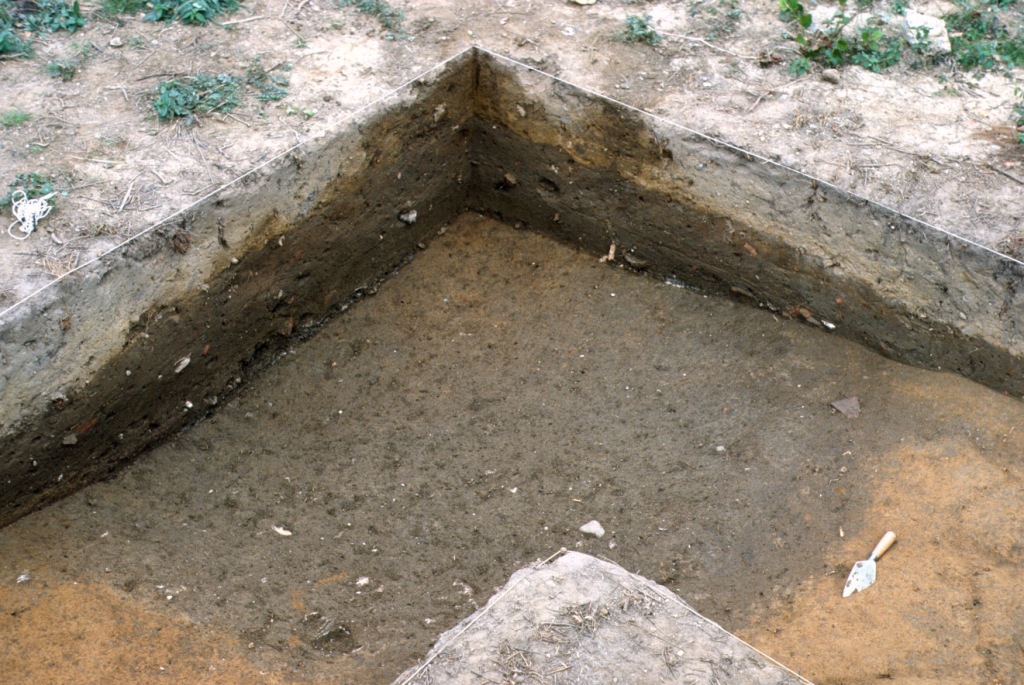 Feature 154G, magazine area, Mattapany plantation, 1985 (Courtesy Naval Air Station Patuxent River, Naval District Washington)
Feature 154G, magazine area, Mattapany plantation, 1985 (Courtesy Naval Air Station Patuxent River, Naval District Washington)
 Feature, magazine area, Mattapany plantation, 1985 (Courtesy Naval Air Station Patuxent River, Naval District Washington)
Feature, magazine area, Mattapany plantation, 1985 (Courtesy Naval Air Station Patuxent River, Naval District Washington)
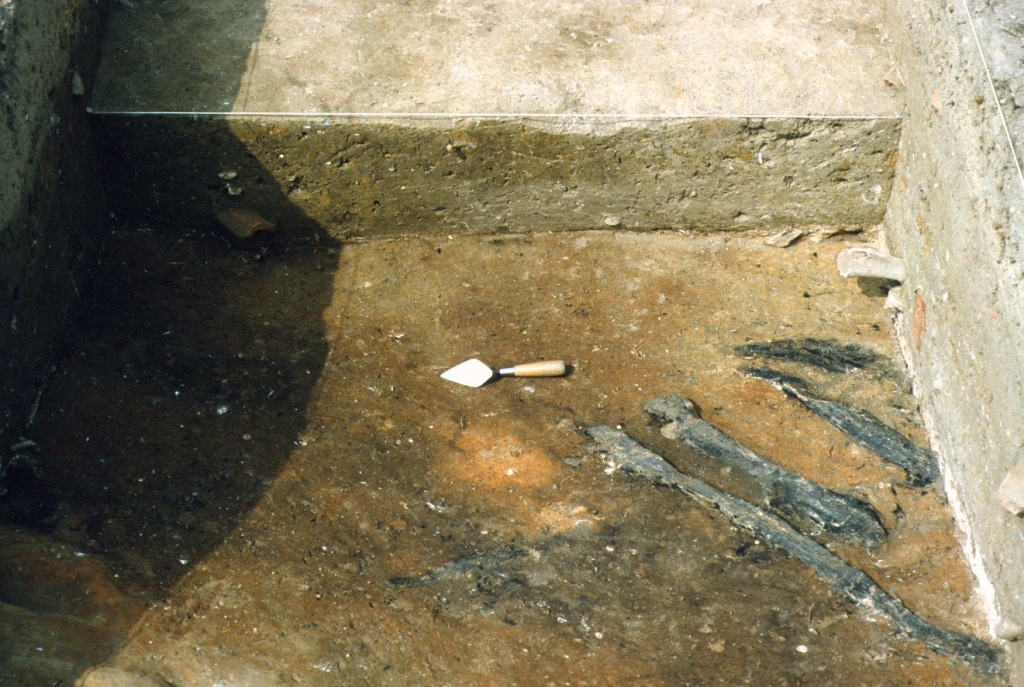 Feature, magazine area, Mattapany plantation, 1985 (Courtesy Naval Air Station Patuxent River, Naval District Washington)
Feature, magazine area, Mattapany plantation, 1985 (Courtesy Naval Air Station Patuxent River, Naval District Washington)
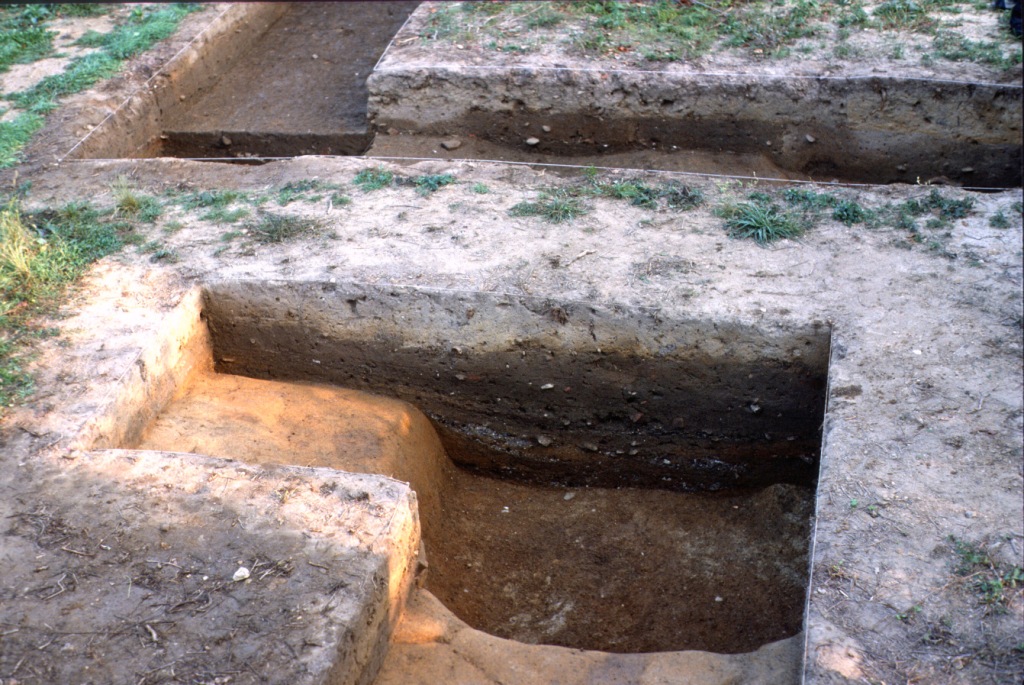 Overall and cross-section, units 133, 153, 154, 155, and 173, magazine area, Mattapany plantation, 1985 (Courtesy Naval Air Station Patuxent River, Naval District Washington)
Overall and cross-section, units 133, 153, 154, 155, and 173, magazine area, Mattapany plantation, 1985 (Courtesy Naval Air Station Patuxent River, Naval District Washington)
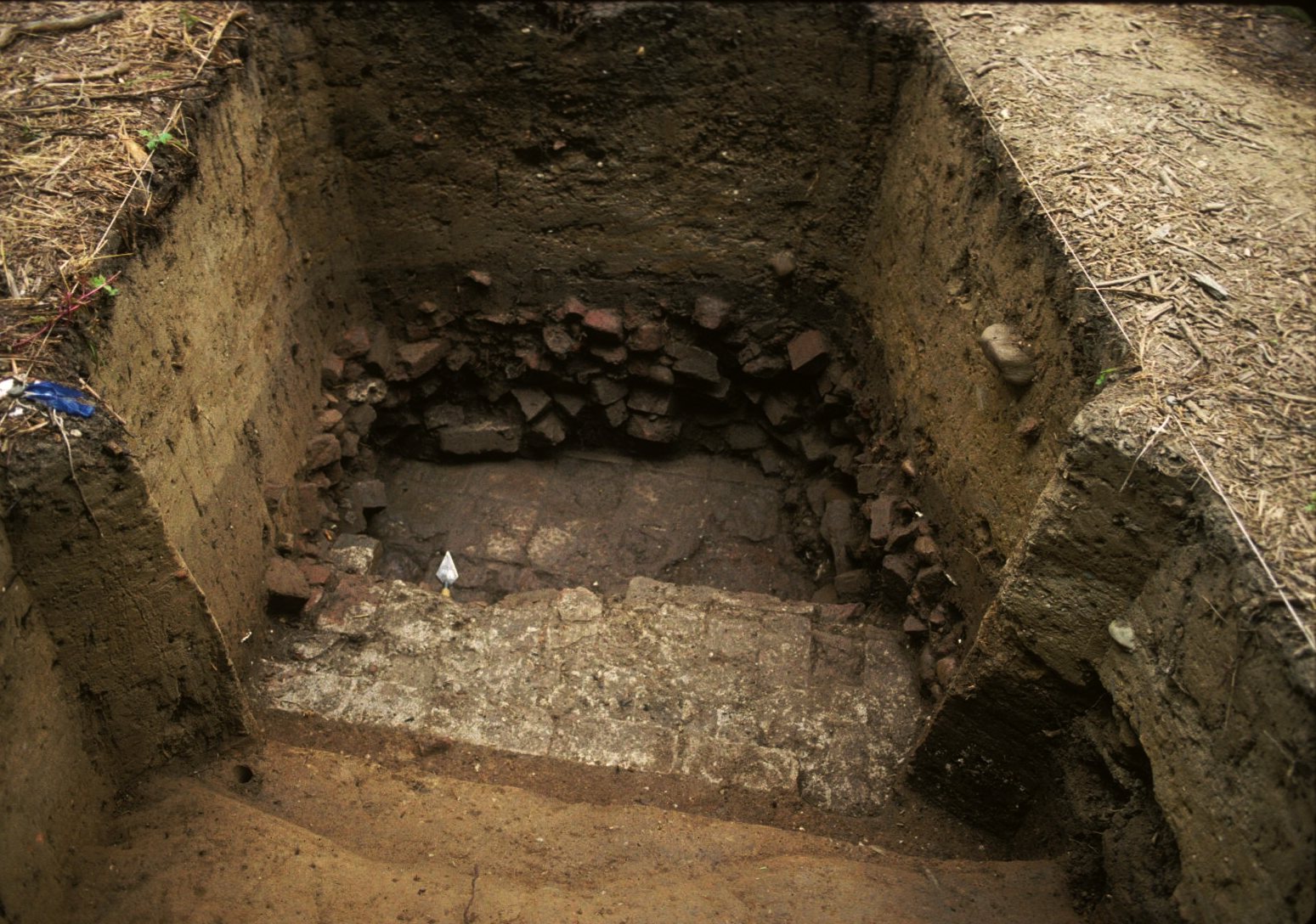 Brick foundation, tile floor, cellar fill, main house, Mattapany plantation (Courtesy Naval Air Station Patuxent River, Naval District Washington)
Brick foundation, tile floor, cellar fill, main house, Mattapany plantation (Courtesy Naval Air Station Patuxent River, Naval District Washington)
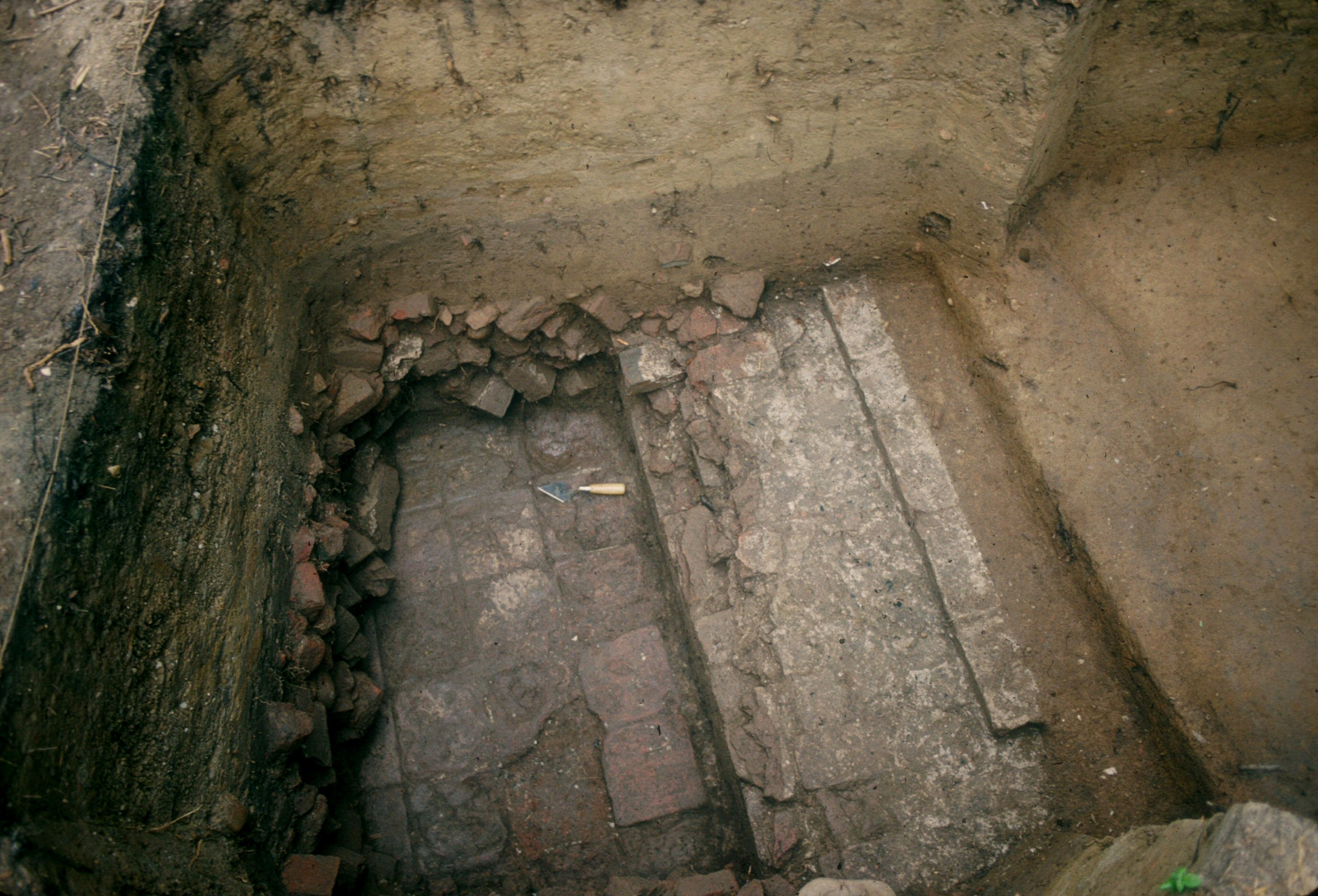 Brick foundation, tile floor, cellar fill, main house, Mattapany plantation (Courtesy Naval Air Station Patuxent River, Naval District Washington)
Brick foundation, tile floor, cellar fill, main house, Mattapany plantation (Courtesy Naval Air Station Patuxent River, Naval District Washington)
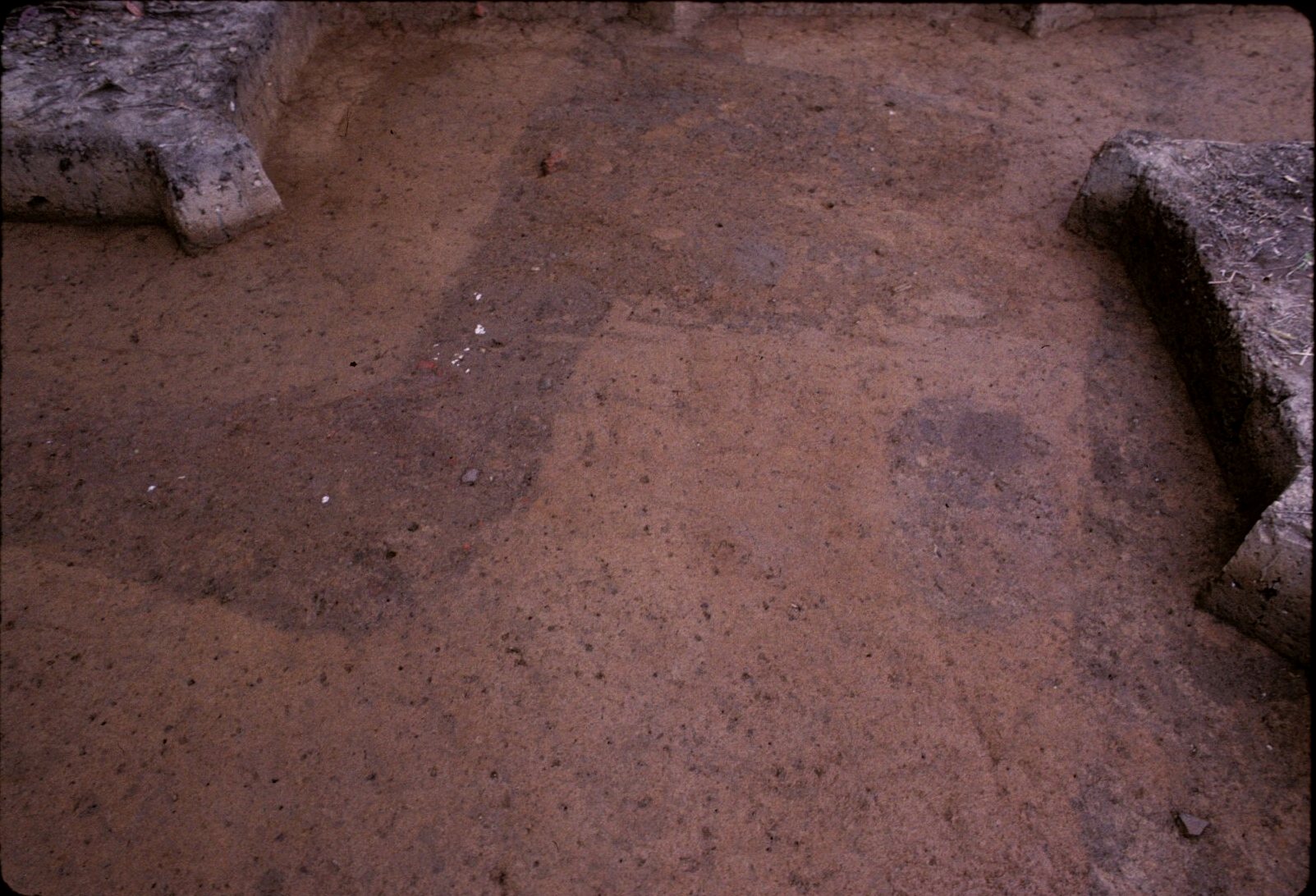 Palisade feature, main house, Mattapany plantation (Courtesy Naval Air Station Patuxent River, Naval District Washington)
Palisade feature, main house, Mattapany plantation (Courtesy Naval Air Station Patuxent River, Naval District Washington)
 Troweling palisade, main house, Mattapany plantation (Courtesy Naval Air Station Patuxent River, Naval District Washington)
Troweling palisade, main house, Mattapany plantation (Courtesy Naval Air Station Patuxent River, Naval District Washington)
Between 1991 and 1997, archaeologists from the Jefferson Patterson Park and Museum, led by Julia A. King and
Edward Chaney, expanded the investigations at 18ST390. The work was funded by the Naval Air Station's Natural Resources
Branch and the Department of Defense's Legacy Resources Program. The purpose of these projects was to better define the
boundaries of the site, to look for additional archaeological resources nearby, and to uncover information about the
structures that once stood at Mattapany. An additional 258 shovel test pits at 25-foot intervals were excavated
and screened through ¼-inch mesh. The results greatly enlarged the site's boundary to the west. A major artifact
concentration 100 yards from the area where Pogue had previously excavated proved to be the location
of Baltimore's house. A total of 71 5-by-5-foot test units were excavated in this location, along with 12 new test units in
the area where Pogue had worked in the early 1980s. All soils were screened through ¼-inch mesh in an effort
to recover a plow zone sample suitable for artifact distribution mapping. All cultural materials were retained,
except for whole bricks and brick bats from the cellars, which were weighed and measured in the field, with a
10 percent sample collected for permanent curation.
Stratigraphy at the site consists of a plow zone (and, in some cases, an early plow zone) overlying subsoil. Navy
activities in the 1950s and 1960s also impacted the site. The Calvert mansion's cellar was apparently still visible and the
depression was filled and capped with a clay fill. Evidence for a steam-pipeline crossing the site was also
found; this steam pipe apparently carried heat to the later ca. 1740 Mattapany house in the mid-20th century.
The pipeline's trench appears to cut through the heart of the site.
The excavations exposed enough of Lord Baltimore's house to demonstrate that it was a substantial, roughly 25-by-50-foot
masonry building with a full cellar, decorative brickwork, and tin-glazed tile around the fireplace. Limited testing
showed that at least a portion of the cellar had a whitewashed ceramic tile floor. An outbuilding, possibly a kitchen,
with a brick-floored cellar, was located next to the main house. A large palisade fence, suggesting the dwelling was
at least partially fortified, linked the two buildings and formed a yard south of the house. Smaller paling fences,
structural posts, and trash pits were found around the buildings.
At the dwelling, portions of the cellar fill in the main dwelling and the cellar fill of the associated service structure
were sampled with the fill excavated through ¼-inch mesh. A small portion of the builder's trench for the principal
dwelling was also excavated, and a portion of a palisade line that had been impacted by mid-20th-century military
construction activities was tested.
In the area of the magazine, a single post hole and mold and a complex of artifact-rich features were identified,
although no obvious plan of a structure was evident. Portions of the feature complex were excavated, revealing large
pits with flat bottoms and at least some with sloping sides. These features do not appear to be borrow pits, and the
sloping sides may suggest a military or magazine function. The magazine features were rich with artifacts.
Artifacts
Pogue recovered more than 2,200 artifacts during his 1981-82 excavations, a total that does not include oyster shell or
architectural objects, which were found in great quantity, then counted, weighed, and discarded in the field (hundreds of
pounds of brick in some proveniences). The 1990s excavations at the magazine, including twelve 5-by-5-foot units, yielded
more than 52,600 artifacts, reflecting the effort to recover and quantify all materials. Indeed, brick accounted for slightly
more than 40,000 artifacts.
The artifacts recovered from the magazine compound indicate an occupation range of ca. 1660-1700, a date which fits
well with the known use period of the magazine. Tin-glazed earthenwares form more than a third of the 1,012 ceramic
sherds recovered (excluding Indigenous ceramics). Dutch, German, and Spanish stonewares and earthenwares were found in abundance
along with locally-made pottery, including Morgan Jones ceramics. English Staffordshire and North Devon products were
less common. Among the notable small finds is a copper alloy coin weight used to measure English "Half Angel" gold coins
minted between 1605 and 1616. Other objects include a nearly complete glass wine bottle, decorative table glass, a
bone die, a copper tobacco box lid, a brass candlestick, a brass bell fragment, a lead-filled gun barrel fragment,
a brass gunstock plate, 55 pieces of lead shot, a button, two leather ornaments, a jet bead, a large iron buckle, a
flat iron, a hammer head, a hoe, and a draw knife.
In addition to the brick, architectural artifacts including plaster, pantile (roofing tile), window lead fragments, a door
latch, and an architectural hinge were recovered from the magazine area of the site. The presence of brick and pantile,
both considered relatively rare in the 17th-century Chesapeake, could suggest the strength of the magazine structure.
The presence of window lead and window glass, however, indicates a high status domestic rather than military use and
provides additional support that the magazine area was originally Henry Sewall's manor house.
The large amount of domestic material recovered both by Pogue and by King and Chaney might seem surprising for
a magazine site, but a large garrison lived there at times, and this location may well have served as a dwelling
for the many servants and slaves known to have lived at Mattapany. It is also possible that the magazine building was originally
Henry Sewall's dwelling house, and that when Charles Calvert built his own residence there, he did so in a location
different from where Sewall's house stood.
The 1990s excavations at the site of Charles Calvert's mansion recovered more than 411,000 artifacts, with architectural
items by far the most abundant. These architectural items include ornamental rubbed and gauged brick (used in jack
arches over windows or doors), Dutch yellow fireplace brick, manganese painted tin-glazed fireplace tile of a style
fashionable among the elite of southern Maryland in the mid-1670s, roofing pantile, ceramic flooring tile, hearthstones,
fine wall plaster, and window glass and lead window cames. Together, these items reveal that Calvert's house was an
impressive structure, much more elaborate than was typical for his contemporaries, but fitting for the Proprietor
of the colony. The house was situated on a raised basement with a central chimney. The recovery of white salt-glazed
stoneware and other 18th-century artifacts indicate that the occupation of the house went on well past that of the
magazine, as is also suggested by historical records.
Among the interesting small finds from the dwelling site was a second coin weight, this one dated 1606 and used for
a gold coin called the "Albertus," minted in the Spanish Netherlands. Coin weights are extremely rare on
17th-century Maryland sites, and the recovery of two at Mattapany reflects the site's role in collecting fees from
ships entering the Patuxent River, as well as Lord Baltimore's efforts to get the Maryland settlers to use coinage
instead of tobacco as currency. Other small finds include a number of copper alloy leather ornaments, brass
furniture tacks, and buttons and buckles.
The faunal assemblage recovered from Mattapany revealed that the site's occupants relied almost entirely on beef,
pork, and mutton for their meat diet. Wild species formed less than two percent of the faunal assemblage's biomass,
including squirrel, rabbit, bird, turtle, and fish. Surprisingly, not a single deer fragment was identified in
the assemblage. When the assemblage is divided between the dwelling and the arms magazine, beef, pork, and
chicken provided the bulk of the meat diet for the dwelling's residents while at the magazine, beef, pork, and
possibly mutton provided the bulk of the meat diet (the mutton may have represented the disposal of two dead animals
rather than food consumption). Wild meat sources at the dwelling included rabbit, squirrel, goose, fish,
and turtle; wild meat sources are negligible at the magazine.
References
Chaney, Edward E. 1999. Phase
I Archaeological Investigations Near Mattapany, Naval Air Station, Patuxent River, St. Mary's County,
Maryland. Report prepared for the Department of Public Works, Naval Air Station, Patuxent River. Manuscript on file,
Maryland Archaeological Conservation Laboratory, Jefferson Patterson Park and Museum, St. Leonard.
Chaney, Edward E., and Julia A. King. 1999. "A
Fair House of Brick and Timber": Archaeological Excavations at
Mattapany-Sewall (18ST390), Naval Air Station, Patuxent River, St. Mary's County, Maryland. Report prepared for the Department
of Public Works, Naval Air Station, Patuxent River. Manuscript on file, Maryland Archaeological Conservation Laboratory, Jefferson
Patterson Park and Museum, St. Leonard.
Flick, Alex J. 2009. "Att A Councell Held Att:" The Politics and Mobility of Maryland's Council, 1637-1695."
St. Mary's Project, on file, St. Mary's College of Maryland, St. Mary's City, MD.
Hatch, D. Brad. 2013. A Report on
the Analysis of Faunal Remains from Mattapany (18ST0390). Prepared for St. Mary's College of
Maryland, St. Mary's City, MD.
King, Julia A., and Edward E. Chaney. 2004. Lord Baltimore's Neighborhood: Standards of Living on the 17th-Century Patuxent
Frontier. Avalon Chronicles 8:261-283.
King, Julia A., and Edward E. Chaney. 1999. Lord Baltimore and the Meaning of Brick Architecture in Seventeenth-Century
Maryland. In Geoff Egan and Ronald L. Michael, eds., Old and New Worlds, pp. 51-60. Oxbow Books, Oxford, England.
Pogue, Dennis J. 1987. Seventeenth-Century Proprietary Rule and Rebellion: Archaeology at Charles Calvert's Mattapany-Sewall.
Maryland Archeology 23(1): 1-37.
Pogue, Dennis J. 1983. Patuxent River Naval Air Station Cultural Resources Survey, Volume I: Archaeology and History. Report
prepared for the Public Works Department, Naval Air Station, Patuxent River, Maryland.
What You Need To Know To Use This Collection
The Mattapany site's artifacts are found in 391 individual proveniences or contexts. For the excavation of test units,
Dennis Pogue adopted the system used at Historic St. Mary's City, which divided the site into 10-by-10-foot squares. Each
10-by-10-foot square was assigned a number, and then subdivided into 5-by-5-foot quads. Each 5-by-5-foot quad was then assigned
an alphabet designation.
King and Chaney used the same grid as Pogue but abandoned Pogue's cumbersome system for labeling units. Each 5-by-5-foot unit was
assigned a unit number and each soil level within that units was assigned a letter designation.
Further Information About the Collection
The Mattapany collection is owned by the United States Navy and curated by the Maryland Archaeological Conservation Laboratory. For
more information about the collection and collection access, contact Sara Rivers Cofield, Federal Collections Manager,
at 410-586-8589; email sara.rivers-cofield@maryland.gov.
To Download Data
Data and a variety of other resources from this site are available for download. To download data,
please go to the Downloads page.